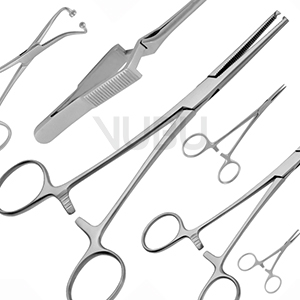Surgical clamps and forceps are indispensable tools in modern surgery. They are used to temporarily secure delicate tissue, control bleeding, or stabilize structures during procedures. Depending on the application and tissue type, these instruments can be divided into various categories, each offering specific features and benefits.
Firm-Grip Clamps
Firm-grip clamps are characterized by low flexibility, meaning they provide minimal give. They exert strong gripping force and are ideal for situations where tissue needs to be held securely and steadily.
Features:
Low flexibility for a firm hold.
Strong gripping force, suitable for robust tissue.
Applications:
Fixation of thick or resistant tissue.
Bleeding control through compression.
Soft-Spring Clamps
Soft-spring clamps feature jaws made of spring steel that gently adapt to the tissue. This design reduces the risk of tissue damage, as they do not exert excessive pressure.
Features:
Spring-loaded jaws for gentle gripping.
Lower risk of tissue injury.
Applications:
Fixation of delicate or thin tissue.
Use in microsurgery or plastic surgery.
Atraumatic Clamps
Atraumatic clamps are equipped with a tissue-friendly tooth profile that minimizes the risk of tissue damage. They provide a secure hold without crushing or injuring the tissue.
Features:
Special tooth profile for gentle gripping.
Ideal for sensitive structures such as blood vessels or intestinal tissue.
Applications:
Vascular and intestinal surgery.
Use in ophthalmology or neurosurgery.
Whether you need long or short-handled clamps, we offer a wide selection of over 250 different types of surgical clamps and forceps. Our range includes, among others:
Bulldog Clamps: For temporary interruption of blood flow in vessels.
Artery Clamps: For controlling bleeding during surgical procedures.
Scalp Clamps: For securing the scalp during neurosurgical procedures.
Tissue Forceps: For grasping and holding tissue.
Intestinal Forceps and Stomach Clamps: For gentle handling in abdominal surgery.
Tonsil Clamps: For securing tonsils during removal.
Dissecting Clamps: For precise tissue dissection.
Gallbladder Clamps and Renal Clamps: Specialized for urological and hepatobiliary procedures.
Hysterectomy Clamps and Parametrium Clamps: For gynecological surgeries.
Pressure Clamps and Hemorrhoid Clamps: For controlling bleeding in proctology.
Sponge Forceps and Swab Holders: For picking up and placing sponges or swabs.
Peritoneum Clamps: For handling the peritoneum.
Tube Clamps: For controlling tubes or drains.
Towel Clamps: For securing surgical drapes.
Our surgical clamps and forceps are more than just instruments—they are precision tools for surgery. They enable surgeons to perform safe and efficient procedures, significantly enhancing patient safety and treatment success. Through collaboration with renowned manufacturers, we guarantee the highest quality and innovation in surgical practice.
For more information about our products or personalized advice, we are happy to assist you. Contact us to learn more about our innovative solutions for surgery.
